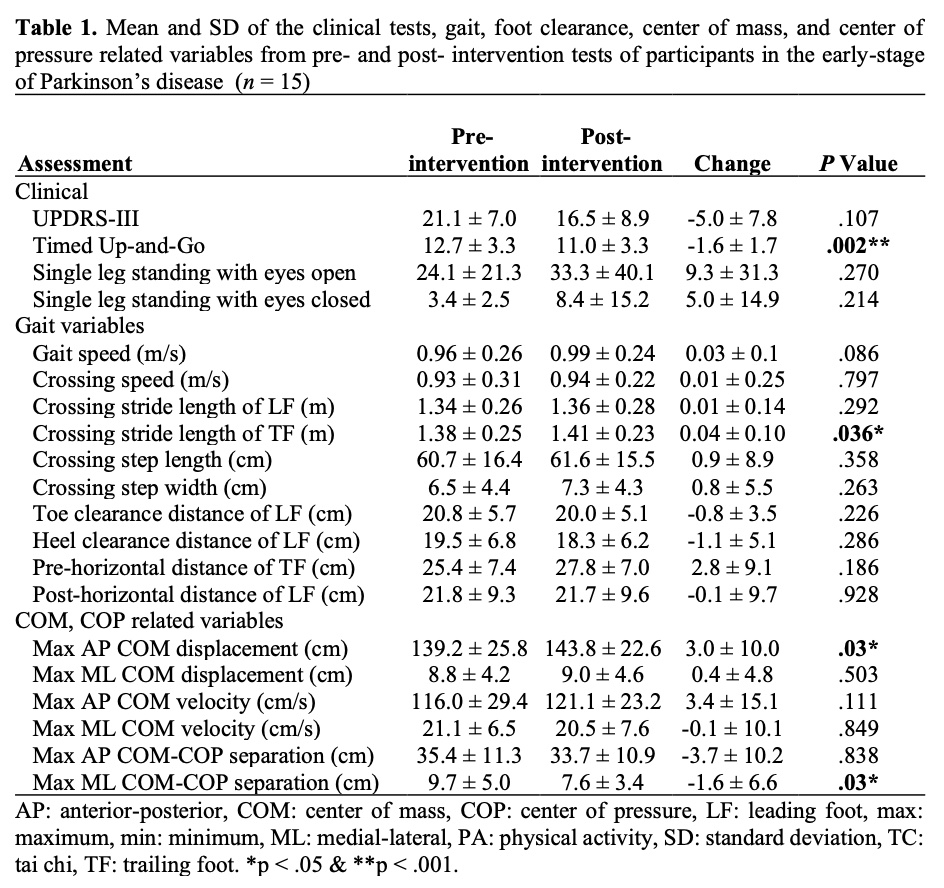Category: Allied Healthcare Professionals
Objective: To examine the effects of an online 12-week biomechanical-based TC intervention on gait and posture in people with Parkinson’s disease (PD).
Background: Postural instability and altered gait are problems reported by those with PD. Exercise such as Tai Chi (TC) is recommended for management of PD, however it is unclear whether TC training could improve postural stability during a challenging locomotion task such as obstacle crossing.
Method: Fifteen individuals in early-stage PD were recruited (age 72.0 ± 6.9 years, Hoehn & Yahr 1 to 2). The biomechanical-based TC intervention program include seven Yang-style forms that was developed based on the TC theory and movement analysis of TC [1], [2]. The participants were enrolled into an online intervention that taught the TC program. The participants met online via ZOOM for 60 minutes, 3 times weekly for 12-weeks. The pre- and post-intervention test in obstacle crossing, timed-up-and-go (TUG) test, and single leg standing (SLS) with eyes open (EO) and closed (EC) were conducted. Gait speed, crossing stride length, clearance height of the heel and toe, anterior-posterior (AP) and medial-lateral (ML) displacement and velocity of the center of mass (COM) and separation of the COM-center of pressure (COP) were analyzed [Table 1].
Results: The participants significantly improved their pre- vs. post-TC intervention performance on TUG test (p = 0.002). During obstacle crossing, the participants significantly increased crossing stride length of the trailing foot, increased AP COM displacement and decreased ML COM-COP separation (p < 0.05); the maximal dorsiflexion angle of the leading limb significantly increased and maximal plantarflexion angle of the trailing limb significantly decreased (p < 0.05).
Conclusion: A 12-week biomechanical-based online TC training was effective towards improvement of gait and postural stability among people in the early-stage of PD. The TC program and online training could be applied for management of PD.
References: [1] N.-Y. Law, J. X. Li, Q. Zhu, and J. Nantel, “Effects of a Biomechanical-based Tai Chi Program on Gait and Posture in People With Parkinson’s Disease: study Protocol for a Randomized Controlled Trial,” https://clinicaltrials.gov/show/NCT04644367, pp. 1–32, 2020, doi: 10.21203/rs.3.rs-412472/v1.
[2] N.-Y. Law and J. X. Li, “Biomechanics analysis of seven Tai Chi movements,” Sports Medicine and Health Science, vol. 20, no. March, pp. 1–68, Jun. 2022, doi: 10.1016/j.smhs.2022.06.002.
To cite this abstract in AMA style:
NY. Law, JX. Li. Effects of an online 12-week Tai Chi intervention on gait and postural stability in individuals with Parkinson’s disease [abstract]. Mov Disord. 2023; 38 (suppl 1). https://www.mdsabstracts.org/abstract/effects-of-an-online-12-week-tai-chi-intervention-on-gait-and-postural-stability-in-individuals-with-parkinsons-disease/. Accessed April 20, 2025.« Back to 2023 International Congress
MDS Abstracts - https://www.mdsabstracts.org/abstract/effects-of-an-online-12-week-tai-chi-intervention-on-gait-and-postural-stability-in-individuals-with-parkinsons-disease/

